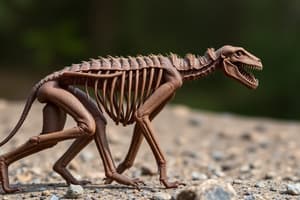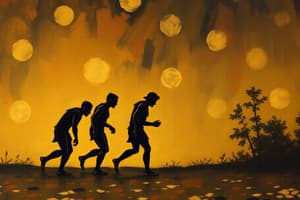Podcast
Questions and Answers
What is adaptive radiation?
What is adaptive radiation?
- The development of hybrids between species.
- Speciation occurring due to behavioral differences.
- A slow evolutionary process involving minor changes.
- Rapid evolution of related species from a common ancestor. (correct)
Allopatric speciation happens in populations located in the same geographical area.
Allopatric speciation happens in populations located in the same geographical area.
False (B)
Define macroevolution.
Define macroevolution.
Evolution leading to the creation of new species.
_____ isolation occurs when species reproduce at different seasons.
_____ isolation occurs when species reproduce at different seasons.
Match the following types of isolation with their definitions:
Match the following types of isolation with their definitions:
Which of the following describes gradualism?
Which of the following describes gradualism?
Character displacement minimizes competition for resources.
Character displacement minimizes competition for resources.
What is the primary focus of systematics?
What is the primary focus of systematics?
What is the primary mechanism proposed by Darwin for evolution?
What is the primary mechanism proposed by Darwin for evolution?
Lamarck's theory of evolution included the idea that organisms can pass on traits acquired during their lifetime.
Lamarck's theory of evolution included the idea that organisms can pass on traits acquired during their lifetime.
What is the Hardy-Weinberg equilibrium condition for population allele frequencies?
What is the Hardy-Weinberg equilibrium condition for population allele frequencies?
In Hardy-Weinberg equilibrium, p + q = ____.
In Hardy-Weinberg equilibrium, p + q = ____.
Genetic drift has a greater effect on large populations compared to small populations.
Genetic drift has a greater effect on large populations compared to small populations.
Match the following agents of evolutionary change with their descriptions:
Match the following agents of evolutionary change with their descriptions:
Random mating ensures that each individual has a ____ chance of reproducing.
Random mating ensures that each individual has a ____ chance of reproducing.
What term is used to describe a group that includes the most recent common ancestor and all its descendants?
What term is used to describe a group that includes the most recent common ancestor and all its descendants?
Homoplasy refers to shared derived characters that are inherited from a common ancestor.
Homoplasy refers to shared derived characters that are inherited from a common ancestor.
What is the term for the ratio of males to females in a population?
What is the term for the ratio of males to females in a population?
A population's geographic distribution is known as its _____ .
A population's geographic distribution is known as its _____ .
Match the following terms with their definitions:
Match the following terms with their definitions:
Which dispersal mechanism involves seeds being blown by the wind?
Which dispersal mechanism involves seeds being blown by the wind?
A uniform spacing pattern in a population is usually the result of strong interactions among individuals.
A uniform spacing pattern in a population is usually the result of strong interactions among individuals.
When populations exchange members, they are referred to as _____ populations.
When populations exchange members, they are referred to as _____ populations.
Which type of survivorship curve is characterized by higher mortality rates later in life?
Which type of survivorship curve is characterized by higher mortality rates later in life?
Semelparity involves producing offspring multiple times throughout the lifespan.
Semelparity involves producing offspring multiple times throughout the lifespan.
What term is used to describe the maximum population supported by the environment?
What term is used to describe the maximum population supported by the environment?
Density-_______ effects are factors that affect reproduction and survival irrespective of population size.
Density-_______ effects are factors that affect reproduction and survival irrespective of population size.
Match the reproductive strategies with their characteristics:
Match the reproductive strategies with their characteristics:
In which type of population are individuals more likely to die at any age?
In which type of population are individuals more likely to die at any age?
Parental investment is higher in r-Selected populations than in K-Selected populations.
Parental investment is higher in r-Selected populations than in K-Selected populations.
Define 'cost of reproduction'.
Define 'cost of reproduction'.
Which of the following ecosystems is characterized by low precipitation, permafrost, and few trees?
Which of the following ecosystems is characterized by low precipitation, permafrost, and few trees?
The Aphotic Zone receives enough sunlight for primary producers to thrive.
The Aphotic Zone receives enough sunlight for primary producers to thrive.
What term describes the mixing of fresh water from rivers with ocean water in coastal areas?
What term describes the mixing of fresh water from rivers with ocean water in coastal areas?
The _____ Zone refers to the area near the surface of a freshwater habitat where sunlight penetrates enough for photosynthesis.
The _____ Zone refers to the area near the surface of a freshwater habitat where sunlight penetrates enough for photosynthesis.
Match the following aquatic ecosystems with their descriptions:
Match the following aquatic ecosystems with their descriptions:
Which of the following describes an oligotrophic lake?
Which of the following describes an oligotrophic lake?
Chad's Prep indicates that the tundra ecosystem covers 50% of the land in northern Alaska and Canada.
Chad's Prep indicates that the tundra ecosystem covers 50% of the land in northern Alaska and Canada.
What is thermal stratification in freshwater habitats?
What is thermal stratification in freshwater habitats?
Flashcards are hidden until you start studying
Study Notes
Evolution
- Evolution is defined as changes in allele frequencies across generations.
- Lamarck theorized that acquired traits are inherited; for instance, a giraffe stretching its neck would produce offspring with longer necks.
- Darwin's theory of natural selection emphasizes "descent with modification" as the mechanism of evolution.
Hardy Weinberg Equilibrium
- Under equilibrium conditions, allele frequencies in a gene pool remain constant.
- Assumptions include: no mutations, no gene transfer, random mating, large population size, and no selection.
- The equations:
- p + q = 1 (p = frequency of dominant allele, q = frequency of recessive allele)
- p² + 2pq + q² = 1 (p² = homozygous dominant, 2pq = heterozygous, q² = homozygous recessive)
Five Agents of Evolutionary Change
- Mutation
- Gene Flow: introduction and movement of alleles between populations.
- Nonrandom Mating: includes assortative, inbreeding, disassortative mating.
- Genetic Drift: random fluctuations in allele frequencies, particularly impactful in small populations.
- Biogeography reveals similar adaptations in different environments due to selective pressures.
Speciation
- A species is a group of interbreeding populations that are reproductively isolated.
- Microevolution focuses on adaptations within species; macroevolution involves the emergence of new species.
- Reproductive isolation mechanisms:
- Prezygotic: ecological, behavioral, temporal, and mechanical isolation.
- Postzygotic: hybrid inviability or infertility.
Types of Speciation
- Allopatric speciation occurs geographically; sympatric speciation happens within the same locale, often through polyploidy or disruptive selection.
- Adaptive radiation results in rapid evolution into various forms from a common ancestor.
- Key innovation introduces new traits that exploit different ecological niches.
- Character displacement reduces competition for resources.
Evolutionary Theories
- Gradualism describes slow, steady changes over time.
- Punctuated equilibrium involves long periods of stasis interrupted by rapid evolutionary bursts.
Systematics and Phylogenies
- Systematics studies evolutionary relationships; phylogeny represents these relationships in tree form.
- Cladistics classifies organisms based on common ancestry.
- Ancestral characters are inherited from a common ancestor; derived characters are unique to a specific group.
- Shared derived characters are known as synapomorphies; shared ancestral characters are symplesiomorphies.
Community Ecology
- A community consists of species in a given area, influenced by local environmental conditions.
- Tundra is characterized by low precipitation, permafrost, and minimal tree growth, supporting cold-weather species like reindeer and wolves.
Freshwater Habitats
- Habitats include lakes, ponds, rivers, and streams with specific zones: littoral, photic, and aphotic.
- Thermal stratification creates distinct water layers with temperature variations affecting ecosystems.
Marine Habitats
- Open oceans are nutrient-poor with limited productivity, whereas continental shelves are rich food sources due to shallow waters.
- Estuaries mix freshwater and saltwater, creating brackish environments with diverse ecosystems.
- Coral reefs are biodiverse and essential for marine life.
- Upwelling regions bring nutrient-rich deep water to the surface, enhancing productivity.
Studying That Suits You
Use AI to generate personalized quizzes and flashcards to suit your learning preferences.



